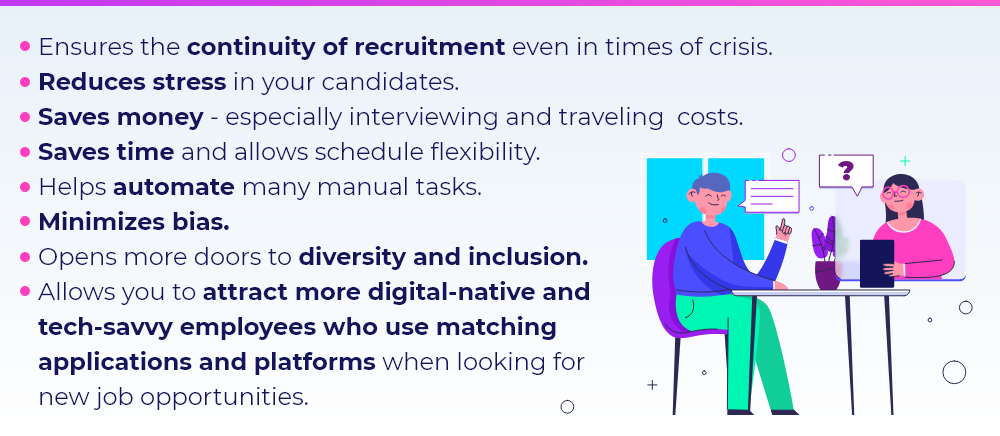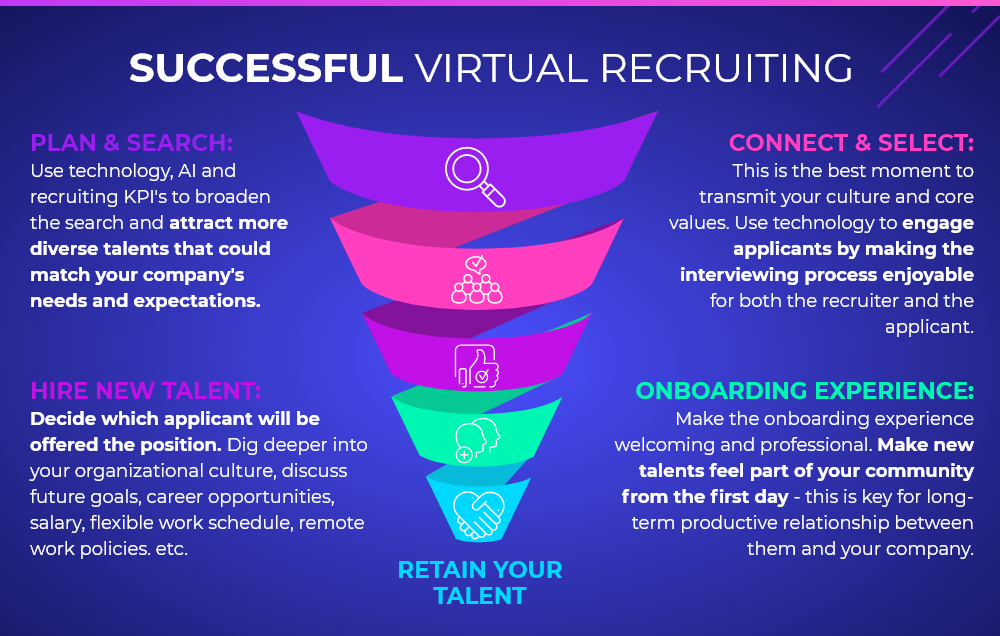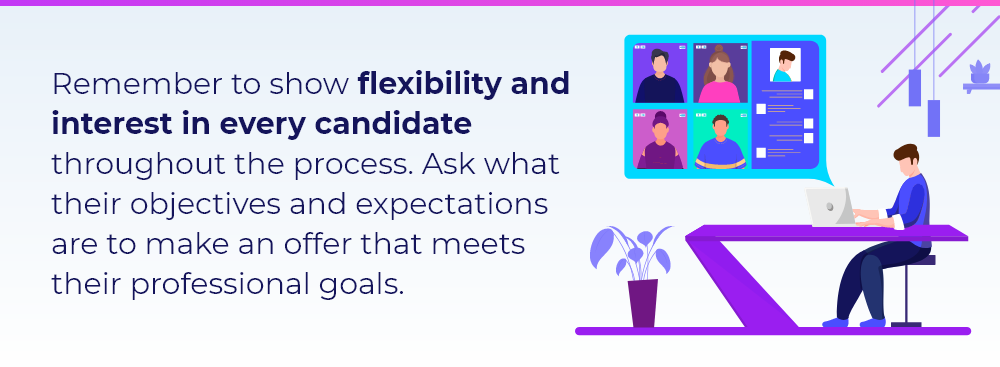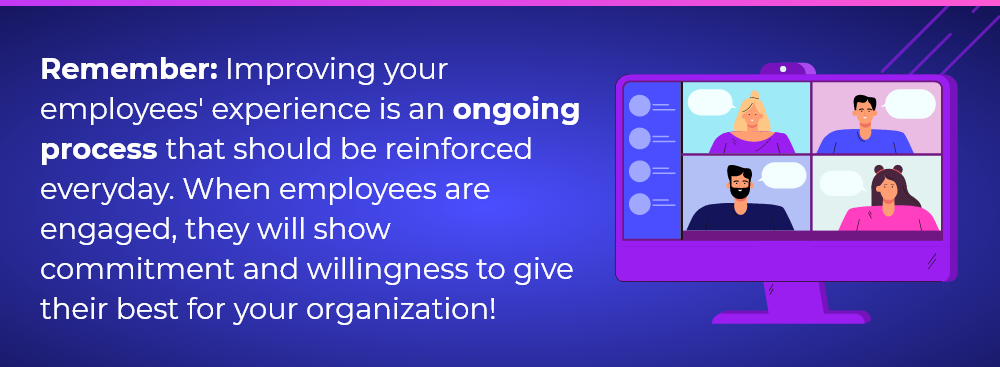Virtual recruiting: everything HR needs to know for a successful experience
Written by María Eugenia Raffaele
When HR sees the virtual recruiting process as an opportunity to grow their talent pool and improve their applicants’ experience, companies are more likely to have engaged and committed employees in the future. It all depends on the way the process is approached and how they make the most of technology and AI to reach better and more accurate results.
How do you attract, hire and retain new talents successfully in this competitive business environment where time and methods need to be optimized to the fullest? You’ll have to read on to find the answer, but let me anticipate the 3 key concepts that will guide this article:
- Virtual recruiting is the best way to avoid the staggering cost of mis-hires and attract the right candidates.
- Technology and AI are essential to find the perfect match for your company.
- Make the process cultural: put candidates at the center all along so that the experience is enjoyable and more productive.
In this article we’ll share the latest virtual recruitment ideas for you to achieve more successful results in your next recruiting experience. As you read, remember to bear in mind this central idea: More than who you hire, how you hire new talents says a lot about your organizational culture. From the first interview, until the employee’s onboard experience, the way you connect with people, and how you make them feel throughout the process will make a difference in your future business results.
Why virtual recruiting, in the first place?
Once upon a time (or several months ago, actually), most company’s employee search parameters were more local and interviews were mostly carried out face-to-face. Today, however, virtual recruiting has become the “new normal” for HR around the world. Although this method is anything but new, it’s proved to be the most efficient one, especially since recent disruptions in the global economy and changes in work models, where social distancing measures apply. So, if you’re still getting familiar with virtual recruiting, here’s why it is the best approach to choose top talents for your company.
Benefits of virtual recruiting
Broadly, the benefits of virtual recruiting revolve around the possibility to access a world of qualified applicants, and to optimize their experience through the use of innovative technology and AI-powered analytics. Specifically, it:

The right use of innovative technology and AI can enhance the modern recruitment process and it helps the work of HR become more strategic and less operational. Among other things, AI allows recruiters to lead data-based, accurate decisions, and it makes the slow steps of analyzing CVs more agile. MInd you, though, technology is not the only ingredient for a successful virtual recruiting. Your organizational culture and the human component during the process are key to guarantee recruitment success.
Steps towards successful recruiting
Our goal here is to help you make recruitment and talent management your competitive advantages, so here are our cutting-edge virtual recruiting best practices to optimize your selection and make your future employee’s journey engaging and cultural from the start.

Stage 1: Plan and search. What competencies are you looking for? What does your company need/aim at in the short and long term? What technology do you have available to make your search precise and inclusive enough?
Remember you’re selecting the people who will represent your company’s values, expectations and overall culture. So, planning is the first most important strategy in the virtual recruiting process. Be as specific and clear as possible concerning the competencies you’re looking for!
Stage 2: Connect & Select. This is the perfect moment to get to know your new talents better and to show them who you are as a company, what direction you’re heading to, and why working with you will make a difference in their professional development.
Candidates need to know about you, so go over these topics to build trust and show transparency from the start! Ideas you can discuss:
- How much does your organization embrace diversity and inclusion?
- What’s your sustainability program?
- What makes your leaders unique?
- What are your company’s remote work policies?
- How effective is your communication?
- What role does feedback play in your company?
- How do you bring teams closer and look after people’s well-being?
Stage 3: Hire new talent. An effective step 2 will make your selection process much easier. Now, it’s the moment to evaluate which candidates are more aligned with your culture, expectations and goals, make them an offer, and discuss future goals.

Stage 4: Onboarding experience. Did you know that 11% of employees change their mind after accepting their job offer as a result of not having a pleasant onboarding experience? The recruiting process doesn’t finish in the hiring stage. Now you’ll be facing the great challenge to plan a successful onboarding experience to retain your talents and increase their loyalty and long-term commitment.
Your new talents’ success will depend on how your managers and the culture of your company pave their way from day one. Research shows that systematic onboarding makes new employees achieve goals 50% quicker and more efficiently. Therefore, the earlier your new hires acquire your culture, feel part of the team and receive clear direction on the what, how, and why, the better.
- Create a memorable first day where new employees get to know their colleagues in a relaxing and friendly context.
- Plan a team-building activity and ice breakers for their first meetings with the team. This will bring them closer to colleagues and leaders.
… and then what? Retain your talents!
To keep up with people’s engagement and retain your talent, you’ll need to make sure your culture continues bringing your people together and connected both emotionally and professionally. Especially in times of remote work, digital solutions like StarMeUp can help organizational cultures become stronger, encouraging employees’ connections and teamwork in a friendly atmosphere where people’s actions are visible and valued.

Globant’s Talent Experience: Culture and agility
Since 2019, Globant has made the most of new technologies such as AI to augment their capabilities and create an innovative approach that would make their virtual recruiting process more agile and cultural. Globant’s Talent Experience is the result of articulated teamwork between recruiters and developers to create a digital solution that would help them find top talents that represent the competencies the company looks for in every Glober.

How does it work?
The initial questionnaires applicants complete optimize the search results by spotting observable behaviors that match the expected competencies and soft skills that recruiters are looking for. With a clearer idea of what the future performance of each candidate would be like, recruiters can reach stage 3 (interview and selection) with a clearer picture of each candidate.
Bernardo Manzella, Recruiting Director at Globant.
The human component plays a fundamental role throughout the process. Globant sees virtual recruiting as a possibility to make candidates’ experience more practical and enjoyable. By giving them the chance to have their first interviews through virtual questionnaires, applicants can find the time and place that works best for them to give their answers without experiencing anxiety or stress. Flexibility and informality are two characteristics that make people’s experience engaging and pleasurable from the start.
Martina Pifarre, Recruiting Manager at Globant.
As I stated before, employees become more loyal, productive and committed to your company when they feel part of an organizational culture that cares for their experience and well-being from the very first interview. Even before people become new members of your staff, make sure you’re always kind, patient and show you care.